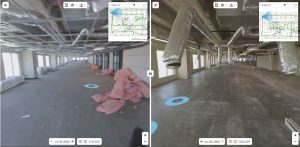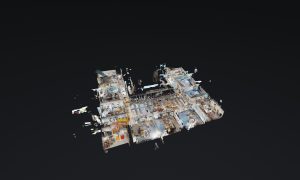Managing the New, Virtual Jobsite
While BIM and other tools have gradually helped bring virtual collaboration into construction, much of the process has continued to be done in person. But COVID-19 changed everything. With limitations on who can be on-site, virtual collaboration has become critical to keeping projects moving forward.
Reality capture tools have been emerging and developing quickly in the construction industry for the last few years. Most recently, STO Building Group has been working with several of the leading technologies, including Holobuilder, OpenSpace, StructionSite, and Matterport.

In Connecticut, Pavarini North East (PNE) had been testing out 360⁰ camera systems like Matterport for punch list purposes and to record existing conditions. Tools like Matterport use 360⁰ cameras to scan a space and translate that data into a three-dimensional “digital twin” that users can walk through virtually. Construction never fully shut down in the state due to COVID-19, so PNE ramped up their use of the tool to keep the project team up to speed on progress. “We had done a scan as a progress report in January and another in March,” says Erik Lavery, PNE project manager. “But we’ve been doing them monthly ever since to coordinate with the full project team.” Using Matterport, the team can “walk through” the 3D version of the space on any device to assess how design items were installed, talk through challenges, or review requisitions and field reports.
In Texas, Structure Tone Southwest (STSW) had begun similar explorations of 3D walk-through tools for a large project with a client and design team located in other areas of the country. “Progress photos were becoming a bear to manage since the site was so big,” says Michael Contreras, STSW senior technology project manager. “The idea of a 360⁰ camera was appealing since a client could see the entire space however they liked and weren’t limited to what they could see in the photos.” Contreras settled on OpenSpace as his tool of choice. Like Matterport, OpenSpace uses 360⁰ cameras to scan the space. But instead of setting up the camera in select locations for the scans, the camera can be mounted on a hardhat, scanning the space as the person wearing it walks through. No matter what route the cameraperson takes, the program stitches the data together to create a full 3D image.
By the time COVID-19 began limiting activity on the jobsite, Contreras and his team were pros at using virtual tools—to the point that it became a competitive advantage as clients and design teams recognized the challenges of collaboration during a pandemic. “We were able to show clients how we could manage project progress without needing them to visit the site,” he says. “It really has helped us keep our projects going, and clients are thrilled they can keep control and visibility without having to go to the site.”

These tools even helped projects stay close to the schedule in areas where construction was completely stopped. In New York, for example, Structure Tone was able to leverage the empty sites to do complete laser scans and 360⁰ camera captures that helped move MEP coordination forward as the team prepared for a full return to work. “We remotely kicked off a phase of MEP coordination on a large job during COVID-19, and we’ll likely complete the whole phase’s coordination without a single in-person meeting,” says Jacob Raskin, virtual design & construction lead at Structure Tone New York. “We have very senior representatives of design and trade firms attending coordination meetings now, and it’s great. As they look at the project in 3D and experience the process, it helps raise the level of knowledge and makes collaboration that much easier.”
Long-time virtual construction advocate Clayton Lyons agrees. Lyons and his Advanced Coordination Team are based in Boston and rarely need to visit their typically New York- or Philadelphia-based projects. Virtual coordination allows his team to save a project time and money, without requiring them—or added labor—to be on-site. “By coordinating the design within the 3D models and getting everything to a buildable set of documents before construction begins, you can significantly streamline who needs to be on-site,” says Lyons. “COVID-19 really made this easier to understand for construction managers, who traditionally have wanted to see everyone in person on the jobsite.”
While COVID-19 certainly ramped up use and engagement in virtual construction tools, the STO team thinks these technologies will increasingly become the norm. “Virtual tools have been around for some time, but COVID-19 pushed the final buy-in for all stakeholders,” says Chris Bailey, creative design manager for Structure Tone London. “Now everyone is realizing that many parts of the process can and should be worked out before you even get on-site.” As more project partners understand and use the models, the applications will only continue to develop. Matterport, for example, is launching a version of its tool that can capture data from an iPhone camera. More and more virtual construction teams are also tying system maintenance and operations information to the models to create a living operations and maintenance manual for facility managers. “These tools will fundamentally change how as-builts are created,” says Brian Boyce, director of operations for Pavarini North East. “There are so many ways to use these tools. It’s been a game-changer for collaboration.” And whether or not collaboration returns to an in-person norm, the industry will continue creating new and better ways to use technology to improve the process.
“These programs are just a few examples of the emerging tools we’re using based on our own experiences and client and partner interest,” says Terry Robbins, STO Building Group chief information officer. “We’re constantly keeping our eye on the market to see which solutions evolve to become the leader and which new tools may have promise.”
